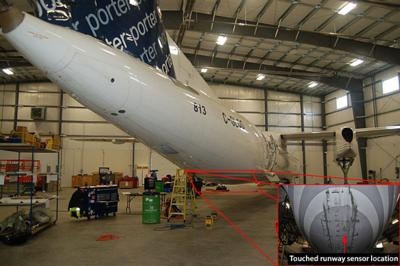Sat, Feb 14, 2015
No Injuries Reported In Incident Involving A Bombardier DHC-8-402
The Transportation Safety Board of Canada (TSB) has released its investigation report (A13O0098) into a May 2013 hard landing and tail strike involving a Porter Airlines Inc. aircraft at the Sault Ste. Marie Airport in Ontario. There were no injuries; however, there was substantial damage to the aircraft.

On 26 May 2013, a Porter Airlines Inc. Bombardier DHC-8-402 flew from the Billy Bishop Toronto City Airport to the Sault Ste. Marie Airport. At 2216 Eastern Daylight Time, during touchdown, the tail struck the runway. After landing, the aircraft taxied to the gate where the passengers were deplaned.
During the final approach to landing, the airspeed began to decrease and the descent rate began to increase. This profile put the aircraft in an unstabilized approach requiring a go-around, but the crew continued with the landing. As the aircraft rapidly approached the runway, instead of increasing engine power to reduce the rate of descent, the pilot pitched the nose up beyond the limits stated in the standard operating procedures and manufacturer's pitch awareness training. The investigation found that the high rate of descent coupled with the high nose-up attitude of the aircraft resulted in the hard landing compressing the struts and allowing the tail to contact the runway.
The investigation also drew attention to the need to clearly define the requirements for a stabilized visual approach, and to clearly define the duties of the pilot monitoring in order to mitigate the risk that unsafe flight conditions could develop.
Immediately following this occurrence, Porter Airlines Inc. initiated an internal investigation as part of its Safety Management System. Part of the immediate corrective action involved a revision of the Pitch Awareness Training highlighting previous occurrences and the need to arrest high descent rates with power and not pitch. The company also conducted a review of training for captains and pilots, reviewed use of flap settings on approach, provided further clarification on the stabilized approach procedure, and re-emphasized hazards associated with night-time operations.
Approach-and-landing accidents are a TSB Watchlist issue. The Board is calling on Transport Canada and operators to do more to reduce the number of unstable approaches that are continued to a landing.
(Image from TSB report)
More News
Ultrahigh Frequency (UHF) The frequency band between 300 and 3,000 MHz. The bank of radio frequencies used for military air/ground voice communications. In some instances this may >[...]
During The 7 Second Descent, There Was Another TAWS Alert At Which Time The Engine Remained At Full Power On October 24, 2025 at 2115 mountain daylight time, a Cirrus SR22T, N740TS>[...]
From 2009 (YouTube Edition): Educational Organization Aims to Inspire by Sharing Tuskegee Story Founding leader Don Hinz summarized the Red Tail Project’s mission in simple, >[...]
“This feels like an important step since space travel for people with disabilities is still in its very early days... I’m so thankful and hope it inspires a change in m>[...]
Also: New Katanas, Kern County FD Training, IndiGo’s Botched Roster, MGen. Leavitt Named ERAU Dean The Australian Transportation Safety Bureau (ATSB) has wrapped up its inves>[...]
 ANN's Daily Aero-Term (12.19.25): Ultrahigh Frequency (UHF)
ANN's Daily Aero-Term (12.19.25): Ultrahigh Frequency (UHF) NTSB Prelim: Cirrus Design Corp SR22T
NTSB Prelim: Cirrus Design Corp SR22T Classic Aero-TV: The Red Tail Project--Carrying the Torch of the Tuskegee Airmen
Classic Aero-TV: The Red Tail Project--Carrying the Torch of the Tuskegee Airmen Aero-News: Quote of the Day (12.19.25)
Aero-News: Quote of the Day (12.19.25) Airborne 12.17.25: Skydiver Hooks Tail, Cooper Rotax Mount, NTSB v NDAA
Airborne 12.17.25: Skydiver Hooks Tail, Cooper Rotax Mount, NTSB v NDAA



